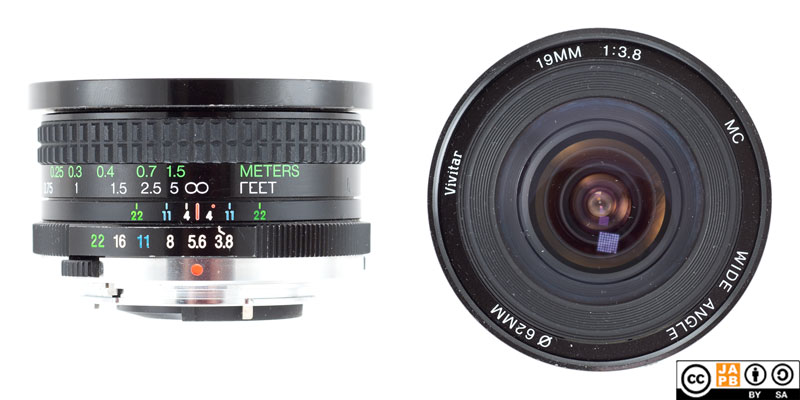Pekka Buttler, 03/2024

Specifications
The table below summarizes the lens’ key specifications (measurements based on pictured, last version of the lens):
| Brand: | Vivitar | Lens name | 19 MM 1:3.8 MC wide angle |
| Focal length(s)1 | 19 mm | Angle-of-view2 | 97,4° |
| Maximum Aperture | f/3.8 | In Production | unknown3 |
| Lens mount (this lens) | Olympus OM | Other lens mounts | multiple4 |
| Length5 | 36,1 mm | Diameter6 | 65,1 mm |
| Filter ring diameter | 62 mm | Weight | 191 grams |
| Lens element count | 9 | Lens group count | 8 |
| Aperture blades (S/R/C)7 | 5 S | Focus throw | 90 ° |
| Minimum focusing distance | 20 cms | Maximum magnification | 1:7.9 |
| Has manual aperture ring | YES | Has Manual focus ring | YES |
| Aperture mechanism type | Automatic | Aperture click stops 8 | 3.8-5.6-8-11-16-22 |
Further notes:
• There are two different lenses that Vivitar sold that shared the very similar mainline specifications, namely a 19 or 20 mm focal length and an f/3.8 maximum aperture. The 20 mm f/3.8 was manufactured my Kiron/Kino precision, while this lens was manufactured by Cosina.
• Interestingly, this 19 mm lens is not really a 19 mm lens, as Cosina marketed the same lens as a 20 mm f/3.8 lens. Whether Vivitar did this subterfuge purely for marketing reasons or partially to differentiate this lens from the Vivitar 20 mm f/3.8 is anyone’s guess.
Versions and variations
Besides having a distant cousin in the Cosina 20 mm f/3.8, the Vivitar 19 mm f/3.8 was manufactured for a broad range of lens mounts, which in itself leads to some variation (with the difference in flange focal differences ranging from 40,5 mm to 46,5). Hence the length of the Vivitar 19 mm f/3.8 will vary significantly based on which lens mount it has. Similarly, some lenses will be all-black (e.g. for Canon FD, Nikon F, or Pentax K), some lenses will have a narrow silver band at the mount-end (Minolta SR) and some will have a broader silver ring (such as the pictured lens, in OM mount).
Also, there seems to be some variation in focusing ring designs, with some samples showing a quadratic pattern in four rows, others having the elongated (pictured) pattern in two rows, with some samples having a thicker rubber ring with cutouts in the form of roman arches.
However, there is nothing to indicate that any of these cosmetic variations would correspond to any
History of Vivitar
Vivitar initially was the trade name used by Ponder & Best Inc. until Ponder & Best changed its name to Vivitar Corp. From the 1960s to the early 2000s the company contracted various (mostly Japanese) optical and electronics manufacturers to manufacture photographic gear to be branded as Vivitar.
You can read more details in the Vivitar company profile.
Adapting
n.B! The following applies to all Olympus OM mount lenses.
This lens cannot be used natively on any current SLR or dSLRs. To use it in its native environment, you will need an Olympus OM film body. Luckily there are a lot of those available, as they remained in production into the 2000s.
Thanks to being a fully manual lens (manual aperture, manual focus), the lens can be adapted to all mirrorless cameras using a suitable adapter. Moreover, a simple ‘dumb adapter’ will do the job perfectly. While the OM mount has been popular, special adapters are not easily available, but one can choose to daisy-chain adapters (e.g. OM->Canon EF; Canon EF –> mirrorless) which also opens up a wide range of special adapters (speed boosters, helicoid adapters, tilt/shift adapters).
Using Olympus OM lenses on dSLRs can also be an easy option, depending on which dSLR.
• Canon EF has the shortest flange focal distance among full-frame dSLR’s and Canon’s wide range of dSLRs are able to Mount Olympus OM lenses perfectly using a simple adapter ring.
• Sony/Minolta A, Pentax K and Nikon F dSLRs are able to use Olympus OM lenses using an adapter that uses corrective optics to allow infinity focus.
Footnotes
- Focal length is (unless stated otherwise) given in absolute terms, and not in Full-frame equivalent. For an understanding of whether the lens is wide/tele, see ‘Angle-of-view’. ↩︎
- Picture angle is given in degrees (based on manufacturers’ specs) and concerns the diagonal picture angle. Rule of thumb:
> 90 ° ==> Ultra-wide-angle
70–90 ° ==> Wide-angle
50–70 ° ==> Moderate wide-angle
40–50 ° ==> ‘Standard’ or ‘normal’ lens
20–40 ° ==> Short tele lens
10-20 ° ==> Tele lens
5-10 ° ==> Long tele lens
< 5 ° ==> Ultra-tele lens ↩︎ - No absolute information could be found, but likely 1970s and early 80s ↩︎
- Including: Canon FD, Contax/Yashica, Konica AR, M42, Minolta SR, Nikon F, Olympus OM and Pentax K ↩︎
- Length is given from the mount flange to the front of lens at infinity. ↩︎
- Diameter excludes protrusions such as rabbit ears or stop-down levers. ↩︎
- S=straight; R=rounded; C=(almost)circular at all apertures. ↩︎
- Numbers equal aperture values on aperture ring; • intermediate click; – no intermediate click. ↩︎